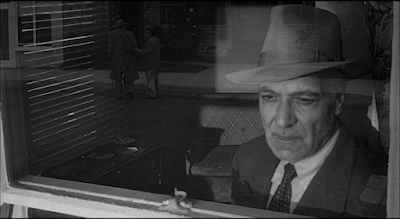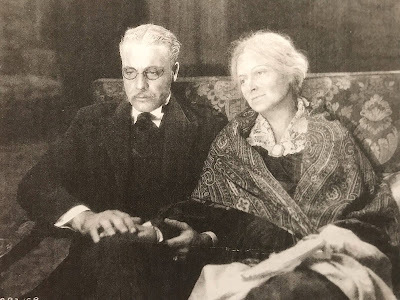Looking back, it’s hard to understand just why some of
the finest filmmakers struggled to make films even, in Orson Welles case, after
Citizen Kane’s re-evaluation and legend continued to grow with it placing
second in the 1952 Sight and Sound best picture poll and first a decade later.
Yet here we have Universal casting for a routine crime caper based on Whit
Masterson’s Badge of Evil and telling star Charlton Heston that they
didn’t have a director yet but were going to cast Welles as Detective Hank
Quinlan. Why don’t you ask Orson to direct? asked Heston and, clearly not having
even considered him, the producers duly brought him on board and, unwittingly,
guaranteed the film would become something different altogether.
Welles hadn’t directed a film in Hollywood since Macbeth
in 1948 (shot in 23 days due to budget constraints) and his reputation for
pursuing his own vision troubled the studios as with von Sternberg and von
Stroheim before him. Here he re-wrote the original script in just ten days and then
began rehearsals during which he encouraged his cast to re-write and improvise
with Janet Leigh saying: “We rewrote most of the dialogue, all of us… and
Mr. Welles always wanted our input… Mr. Welles wanted to seize every moment. He
didn't want one bland moment…”
Well, viewing this sparkling new HD presentation I can
reveal that, unsurprisingly, there are indeed no bland moments in what remains
a spellbinding film on so many levels. Let me count the ways…
 |
1. The
dark night rises
There’s no way of overlooking the astonishing dexterity
of the film’s opening take, as characters move to and fro with two couples in
two cars heading in close proximity through a border town at night, one of
which has just had a bomb thrown in its boot. Russell Metty’s camera sweeps up
and over buildings following the vehicles and focusing on one then the other as
the viewer waits for the inevitable explosion which, at various points, could
engulf both cars. It’s an audacious single take that Antonioni would be proud
of, pure technique that creates a sense of place, establishes characters,
motivations and atmosphere from the get-go.
According to Charlton Heston, interviewed in one of the
extras, the actor playing the border guard who speaks right at the end of the
take, just couldn’t take the pressure and kept fluffing his lines. As the sun
began to rise and the final take approached, Welles told him to mime his lines
and the take was finally in the can. The director was asked why he didn’t just
replace the actor and responded by saying that it would be too cruel, and that
it would destroy him. Now that’s leadership.
The story takes place largely at night and that adds so
much to the tensions of the film, it’s too late, you can’t orientate and it’s always
darkest just before the dawn. We’re instinctively nervy during the nighttime,
extra alert for predatory attack and in search of safety, a security that
Welles will not allow and which frazzles the longer the film progresses. The dark
silence highlights human extremes and evil is exposed in vivid ways; we are,
indeed, touched by it. After Hours, Mystery Train, Night on Earth… anything by David Lynch, there’s
an entire sub-genre of films at night at least partially inspired by this film.
 |
| Orson Welles |
2. The
cast is politics
Welles re-wrote the story’s original good cop Mitch Holt as
the Hispanic Miguel Vargas, making the character a Mexican "for political
reasons. I wanted to show how Tijuana and the border towns are corrupted by all
sorts of mishmash, publicity more or less about American relations". This
was a bold choice and boy you can imagine how this might go down in parts of
the South in 2023…
Heston duly darkened his hair and skin and whilst it’s
odd to see there’s something about seeing this quintessential all-American hero
as a Mexican which is challenging in its own way; he’s the good man whilst the Caucasian
cop will be the ultimate villain. People got blacklisted for less a few years
earlier.
Welles, of course, plays the corpulent Police Captain
Hank Quinlan, a man still haunted by the murder of his wife and a recovering
alcoholic dedicated to keeping his town clean at whatever cost. Welles is truly
disturbing in this role, the prosthetics an eerie foreshadowing of his later
weight, whilst also changing his face so successfully that even in 4k HD, you
really can’t see the joins. It’s as if the choices he has made have not only
darkened his soul but marked him for life too… hints of handsomeness submerged
beneath synthetic skin.
 |
| Joseph Calleia, reflects on his friend... |
Joseph Calleia as Sgt. Pete Menzies delivers a stunning
performance too as Quinlan’s loyal right-hand man who has honestly assisted his
friend through the years. Calleia manages to convey a mix of febrile weakness
as well as bravery and steals a fair few scenes in the most human ways; a
visceral conduit to the audience as we’re sucked into this violent world of
betrayal and midnight corruption.
Balanced against this is the blonde purity of Janet Leigh
who plays Vargas’ American wife, Susan again the epitome of upstanding American
values and a quick-witted, woman of agency who still finds herself suffering
the indignities of kidnap, blackmail and molestation all because her man is
perhaps too intent on pursuing his prey without spending enough time making
sure she is safe. What happens to Susan represents the dark paranoia of the
times with the brother of Vargas’ crime lord Manolo Sanchez (a tense, sweaty
turn from Victor Millan) aiming straight for his weakness just as Quinlan
eventually arrives at the same conclusion in the most horrific of ways.
3. Mercedes menace, Marlene magic
The film is unsettling throughout, it’s dark, confusing,
juddering… things happen out of nothing, the natural rhythm is slightly off, no
doubt down to Welles’ coaxing and the pacing, editing and improvisation he
encourages. A man follows Vargas through the shadowed streets and runs out of
the darkness and attempts to throw acid at him; this world is out of kilter and
there is nothing stopping the worst things from happening. As Susan is staying
at the supposedly safe motel over the border, the only man standing between her
and a gang of Sanchez’ hoods is a night manager player with weird intensity by Dennis
Weaver; his palpable terror only reinforcing how alone and vulnerable she is.
The gang party, play rock ‘n roll, take drugs and circle ever closer to their
prey… with Mercedes McCambridge providing a brutal cameo as the butch gang
leader who wants to stay and watch as the men break into Susan’s room…
 |
| Janet Leigh you should avoid motels in future... |
McCambridge had been part of Welles’ cast for War of
the Worlds in 1938 and she’s joined by a number of Orson’s pals, Joseph Cotton
as a coroner, Zsa Zsa Gabor as a club owner and, most memorably, Marlene Dietrich
as Tana a gypsy madam in what she said was Elizabeth Taylor’s wig*. In her
autobiography she said the shoot had been only one night and that “I don’t think
I’ve ever performed so well as on that day…” The budget amounted to what she
called “a hand-out to a beggar” and so she, Mercedes and the rest responded to
their friend’s call for help and the quality of their performances speaks
volumes of the respect and loyalty the director clearly commanded.
4. Vision, requirements and specification
The studio hacked the film to buts but the director wrote
a detailed 58-page memo detailing everything in the film he wanted re-instated
and put right. This was used to restore the film when it was re-edited
according to Welles's original vision, as outlined in his memo, in 1998,
showing the value of not only having clear vision and terms of reference but
also documenting requirements and deliverables if any project managers are
watching/reading.
This then is something like a definitive edition – so far
– of this major work and as usual comes replete with Eureka’s special set of
extras:
·
Hardcase featuring artwork by Tony Stella | 4K
(2160p)
·
UHD Blu-ray presentations of all three versions,
presented in Dolby Vision HDR: the Theatrical version (95 mins), the Preview
version (109 mins), and the 1998 Reconstruction (110 mins).
·
Four audio commentaries, featuring: restoration
producer Rick Schmidlin (reconstructed version); actors Charlton Heston &
Janet Leigh, with Schmidlin (reconstructed version); critic F. X. Feeney (theatrical
version); and Welles scholars James Naremore & Jonathan Rosenbaum (preview
version) New video interview with critic, broadcaster and cultural historian
Matthew Sweet
·
New video interview with critic Tim Robey
·
New video interview with author and critic Kim
Newman
·
Bringing Evil to Life and Evil Lost
and Found – two video pieces, featuring interviews with cast and crew, as
well as critics and admirers
·
Original theatrical trailer
·
PLUS: A 100-PAGE BOOK featuring writings by
Orson Welles, François Truffaut, André Bazin, and Terry Comito; interview
excerpts with Welles; a timeline of the film’s history; two new essays by
critic Richard Combs; and rare stills and imagery.
You can order the set direct from Eureka here or via
all good retailers, no home should be without one!
*Marlene (1987)











%20slap.png)
%20hope%202.png)






%20Antonio.jpg)









%20look.png)
%20dinner.jpg)
%20Boo!.png)


%20look.png)
.png)
%20smile.png)
%20I%20can't%20miss%20geometry%20class.png)
%20snow.png)
%20Kyiv.png)
%20Kyiv%20&%20Couple.png)




+colour.png)





